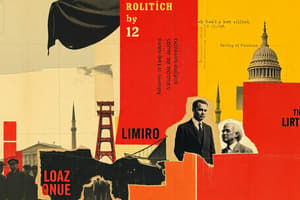Podcast
Questions and Answers
What role does soliloquy play in a play?
What role does soliloquy play in a play?
- It interrupts the flow of dialogue with physical actions.
- It reports the words of a character to another.
- It conveys dialogue heard by all characters.
- It directly relays the character's thoughts to the audience. (correct)
Which context refers to the actual setting of interaction?
Which context refers to the actual setting of interaction?
- Personal context
- Cognitive context
- Physical context (correct)
- Social context
What is the main function of transitivity in discourse?
What is the main function of transitivity in discourse?
- To represent patterns of experience in texts. (correct)
- To emphasize indirectness and politeness in communication.
- To clarify dialogue with insertion sequences.
- To connect elements of discourse through conversation.
Which term describes the interaction pattern between speakers during a conversational exchange?
Which term describes the interaction pattern between speakers during a conversational exchange?
What does the axis of selection in discourse refer to?
What does the axis of selection in discourse refer to?
What is the purpose of metastatements in a conversation?
What is the purpose of metastatements in a conversation?
Which of the following best illustrates conventionalized indirectness?
Which of the following best illustrates conventionalized indirectness?
How does the concept of directness function in discourse?
How does the concept of directness function in discourse?
What best describes narrative discourse in the context of storytelling?
What best describes narrative discourse in the context of storytelling?
How does metonymy function in language?
How does metonymy function in language?
Which example illustrates a mixed metaphor?
Which example illustrates a mixed metaphor?
What is the primary function of caricature in narrative and visual representation?
What is the primary function of caricature in narrative and visual representation?
What do orientational metaphors primarily rely on?
What do orientational metaphors primarily rely on?
In the context of dialogue, how do embedded utterances function?
In the context of dialogue, how do embedded utterances function?
What does the term 'concretization' refer to in narrative techniques?
What does the term 'concretization' refer to in narrative techniques?
How does the sociolinguistic mode influence narrative?
How does the sociolinguistic mode influence narrative?
Which aspect of stylistics allows for a deeper understanding of linguistic structure and function?
Which aspect of stylistics allows for a deeper understanding of linguistic structure and function?
What method focuses on presenting familiar ideas in unfamiliar ways to change reader perception?
What method focuses on presenting familiar ideas in unfamiliar ways to change reader perception?
Which of the following describes the function of language that highlights its aesthetic qualities?
Which of the following describes the function of language that highlights its aesthetic qualities?
What is an example of internal foregrounding in a narrative?
What is an example of internal foregrounding in a narrative?
Which principle of stylistic analysis allows results to be verified by other researchers?
Which principle of stylistic analysis allows results to be verified by other researchers?
Which of the following is NOT a type of poetic function?
Which of the following is NOT a type of poetic function?
What does the principle of 'foregrounding' primarily relate to?
What does the principle of 'foregrounding' primarily relate to?
How does the conceptual metaphor 'time is money' function?
How does the conceptual metaphor 'time is money' function?
Which component of transitivity represents the action occurring in a clause?
Which component of transitivity represents the action occurring in a clause?
What type of process is represented by the verb in the sentence 'The student fell asleep'?
What type of process is represented by the verb in the sentence 'The student fell asleep'?
Which type of relational process describes a relationship of equivalence?
Which type of relational process describes a relationship of equivalence?
What is the role of the 'Carrier' in an attributive relational process?
What is the role of the 'Carrier' in an attributive relational process?
Which of the following is true about existential processes?
Which of the following is true about existential processes?
In the context of transitivity, what does 'meronymic agency' refer to?
In the context of transitivity, what does 'meronymic agency' refer to?
Which component of an existential process involves nominalization?
Which component of an existential process involves nominalization?
In stylistics, what is primarily assigned importance in interpreting a text?
In stylistics, what is primarily assigned importance in interpreting a text?
What does morphology study in language?
What does morphology study in language?
Which of the following best describes pragmatics in language?
Which of the following best describes pragmatics in language?
How does gradability apply to adjectives?
How does gradability apply to adjectives?
What are the main components that define the register of language?
What are the main components that define the register of language?
Which type of conjunction would best exemplify subordination?
Which type of conjunction would best exemplify subordination?
What is the function of a tautology in language?
What is the function of a tautology in language?
Which of the following statements about dialects is true?
Which of the following statements about dialects is true?
What does the rank scale in grammar indicate?
What does the rank scale in grammar indicate?
Flashcards
Narrative Discourse
Narrative Discourse
The way a story's plot is told, focusing on techniques like flashbacks and repetition. It's how the story is realized in the written text.
Narrative Plot
Narrative Plot
The abstract structure of a story's events, the sequence of actions that make up the narrative.
Metaphor
Metaphor
Comparing two different concepts to explain something. One concept (the source domain) is used to understand the other (the target domain).
Metonymy (Synecdoche)
Metonymy (Synecdoche)
Signup and view all the flashcards
Caricature
Caricature
Signup and view all the flashcards
Concretasation
Concretasation
Signup and view all the flashcards
Mixed Metaphor
Mixed Metaphor
Signup and view all the flashcards
Orientational Metaphors
Orientational Metaphors
Signup and view all the flashcards
Transitivity
Transitivity
Signup and view all the flashcards
Process
Process
Signup and view all the flashcards
Participant
Participant
Signup and view all the flashcards
Circumstance
Circumstance
Signup and view all the flashcards
Material Process
Material Process
Signup and view all the flashcards
Mental Process
Mental Process
Signup and view all the flashcards
Behavioral Process
Behavioral Process
Signup and view all the flashcards
Verbal Process
Verbal Process
Signup and view all the flashcards
Physical Context
Physical Context
Signup and view all the flashcards
Personal Context
Personal Context
Signup and view all the flashcards
Cognitive Context
Cognitive Context
Signup and view all the flashcards
Exchange
Exchange
Signup and view all the flashcards
Insertion Sequence
Insertion Sequence
Signup and view all the flashcards
Axis of Combination
Axis of Combination
Signup and view all the flashcards
Axis of Selection
Axis of Selection
Signup and view all the flashcards
Metastatements
Metastatements
Signup and view all the flashcards
Phonology/Phonetic
Phonology/Phonetic
Signup and view all the flashcards
Graphology
Graphology
Signup and view all the flashcards
Morphology
Morphology
Signup and view all the flashcards
Syntax/Grammar
Syntax/Grammar
Signup and view all the flashcards
Lexical Analysis/Lexicology
Lexical Analysis/Lexicology
Signup and view all the flashcards
Semantics
Semantics
Signup and view all the flashcards
Pragmatics/Discourse Analysis
Pragmatics/Discourse Analysis
Signup and view all the flashcards
Rank Scale
Rank Scale
Signup and view all the flashcards
Stylistics
Stylistics
Signup and view all the flashcards
Foregrounding
Foregrounding
Signup and view all the flashcards
Ostranenie
Ostranenie
Signup and view all the flashcards
Poetic Function
Poetic Function
Signup and view all the flashcards
Conceptual Metaphor
Conceptual Metaphor
Signup and view all the flashcards
Internal Foregrounding
Internal Foregrounding
Signup and view all the flashcards
Replicable
Replicable
Signup and view all the flashcards
Retrievable
Retrievable
Signup and view all the flashcards
Study Notes
Narrative Stylistics
- Narrative Discourse: Connects language patterns to a series of events.
- Narrative Plot: Abstract storyline with sequences, narrated via flashbacks and repetitions, representing realized texts.
- Textual: Physical channel.
- Sociolinguistic Mode: Historical, cultural, and linguistic setting (Time & Place).
- Action & Events: How the development of characters intertwines with the story.
- Point of View: Relationship between narration and narrator's perspective.
- Textual Structure: How narrative units are organized.
- Intertextuality: Reversed allusion.
Metaphor
- Metaphor: Connects two concepts (Target/Source domain).
- Repeating Metaphors: Lead to idioms/fixed expressions.
- Metonymy (Synecdoche): Part represents the whole (e.g., "a fresh pair of legs").
- Producer & Produced: Producer represents the produced (e.g., "Have you read the new Kate Atkinson?").
- Location & Institution: Location/institution represents the whole (e.g., "The Pentagon refused to comment on the story").
- Instrument & User: Instrument represents the user (e.g., "The lead guitar has gone AWOL").
- Meronymic Agency: Part stands for the whole (e.g., "voice" represents the teacher).
- Caricature: Distortion of human appearance, highlighting personality traits or flaws.
Concreteness/Figurative Language
- Concretization: Abstract to tangible (e.g., "She loved him deeply" > "knitting him a warm sweater").
- Mixed Metaphor: Blended idioms (e.g., "burning the midnight oil at both ends").
- Extending: Use of linguistic resources to introduce new conceptual elements from the source domain.
- Orientational Metaphors: Uses space to track human emotion. (e.g., Good is Up).
Dialogue & Interaction
- Dialogue: Interaction on two levels (one discourse within another).
- Contextual Levels:
- Fictional context (within the play).
- 'Real' context (framing interaction between author and reader).
- Dialogue Embedding: Breaking down layering pattern; words relayed to reader/audience.
- Assumptions: Assumptions made concerning dialogues in the play and the real world are connected.
- Contexts:
- Physical context(setting).
- Personal context (relationships among participants).
- Cognitive context (knowledge base).
Structure and Interactions
- Axis of Combination: Structural frame for dialogue units.
- Axis or Selection: Connects discourse elements to strategy.
- Exchange: Back-and-forth interaction, usually with one party initiating an inquiry and the other responding.
- Insertion Sequences: Brief interruptions to clarify or add information.
- Directness/Indirectness: Clarity and conciseness; politeness.
- Conventionalized Indirectness: Grammatical form used for questions instead of commands/requests.
Transitivity
- Transitivity: Way meanings are encoded in clauses, different process types represented.
- Components of Process: Process (Verb phrase), participants (Noun phrase), Circumstances (Prepositional/Adverb phrase).
- Types of Processes: Material (doing), Mental (sensing), Behavioral(physiological action), Verbalization(saying), Relational(establishing relationships).
- Existential Process: Existence of something/happening.
- Transmission of Actions/Events: Semantic processes for development through participant roles.
Stylistics and Language
- Stylistics: Method of textual interpretation focusing on language.
- Stylistic Analysis: Techniques to gain insights into linguistic structure/function in literary/other texts.
- Language in Context: Language is context-dependent; utterances (literary and otherwise) are contextually situated.
- Creativity and Innovation: Should not be limited to literary writing.
- Purposes: Explore language use creativity. Tells about language rules(L).
- Principles: Rigorous, retrievable, and replicable analysis.
Foregrounding & Other Methods
- Foregrounding: Textual patterning with literary-aesthetic motivation; examples include rhyme, deviation, repetition within texts & across texts.
- Ostranenie: "Defamiliarization" of familiar concepts by presenting them in unusual ways.
- Internal Foregrounding: Deviation within the text, for example, a sudden tone shift.
- Poetic Function: Conative (persuasion), Phatic (establishing communication), Referential (information conveyance), Emotive (speaker's emotions), Poetic (form/aesthetic qualities).
- Metalingual: Explaining or clarifying language itself. Example: Defining a word or describing a concept metaphor
- Conceptual Metaphor: Understanding an abstract concept through another.
Levels of Language
- Phonology: How words are pronounced.
- Graphology: How language is written.
- Morphology: How words are constructed.
- Syntax: How words combine into phrases.
- Lexical Analysis: Vocabulary of a language.
- Semantics: Meaning of words.
- Pragmatics: Meaning of language within social context.
- Grammatical Constituents (Morphemes): Smaller parts forming words and phrases.
Other Concepts
- Truth Value: Conditions under which a sentence is considered true or false.
- Orientation Function of Language (Deixis): Language related to orientation(location/time/participants).
- Gradability: Degree of intensity in adjectives' qualities, examples include comparative, superlative and equal.
- Classifying Adjectives: Specify relative fixed qualities pertaining to a noun.
- Tautology: Repeating the same thing twice (e.g., "War is war.").
- Accents/Dialects/Register: Distinguishing speech patterns via pronunciation, grammar, vocabulary, communication setting & purpose, relationship between speakers, mode of communication (spoken/written).
- Rank Scale (Grammatical Units): Units' hierarchical order based on size (Clause > Phrase > Word > Morpheme).
- Sub/Predictor/Complement/Adjunct: Grammatical constituents' arrangement within sentences.
- Coordination/Apposition/Subordination/Embedding: Grammatical relations between clauses or phrases. (examples: For, And, Nor, But, Or, Yet, and So. Or: makes variable reference)
- Trailing Constituents & Anticipatory Constituents: Structure of constituent placement in sentences
Studying That Suits You
Use AI to generate personalized quizzes and flashcards to suit your learning preferences.
Related Documents
Description
Explore the intricacies of discourse analysis and narrative techniques with this quiz. It covers concepts such as soliloquies, transitivity, and the use of metaphors in storytelling. Test your understanding of how these elements contribute to communication and narrative structure.




